USA & Canada 1-416-619-7795
|
UK:+44 1753 201 201
|
Australia : 61-2-86078986
|
Cell/WhatsApp: + 44 ( 0 ) 7739 716978
Delhi, a city with a storied past and vibrant present, encapsulates the essence of India through its juxtaposition of ancient heritage and modernity. Old Delhi, once the majestic capital of the Mughal Empire, and New Delhi, the seat of British colonial power and now the capital of India, together form a fascinating tapestry of history, culture, and contemporary urban life.
Historical Splendor
Old Delhi, or Shahjahanabad, established in the 17th century by Mughal Emperor Shah Jahan, is a testament to the grandeur of Mughal architecture. The Red Fort, a UNESCO World Heritage site, stands as a symbol of India’s struggle for independence and its rich past. The bustling lanes of Chandni Chowk, with their labyrinthine bazaars, offer a glimpse into the city’s historical commercial hub, where tradition meets the everyday hustle of life.
In stark contrast, New Delhi, designed by British architects Sir Edwin Lutyens and Herbert Baker in the early 20th century, exemplifies colonial-era planning with wide avenues, imposing buildings, and lush gardens. The India Gate, an iconic war memorial, and Rashtrapati Bhavan, the official residence of the President of India, are quintessential landmarks of New Delhi’s colonial legacy.
 The Historical Charms of Old Delhi
The Historical Charms of Old Delhi
Old Delhi, also known as Shahjahanabad, was founded by Mughal Emperor Shah Jahan in the 17th century. This area is steeped in history and showcases the opulence of the Mughal era through its architecture, bustling bazaars, and cultural richness.
 The Elegance of New Delhi
The Elegance of New Delhi
In contrast to the historical allure of Old Delhi, New Delhi represents the architectural and cultural ambitions of the British colonial era. Designed by Sir Edwin Lutyens and Herbert Baker, New Delhi is characterized by wide boulevards, lush gardens, and impressive government buildings.
Experiencing Delhi’s Cultural Mosaic
Delhi’s cultural scene is as diverse as its history. From traditional arts to contemporary performances, the city offers a plethora of cultural experiences.
Delhi, with its blend of Old and New, offers an unparalleled experience for tourists. From the historical lanes of Old Delhi to the planned avenues of New Delhi, every corner of the city tells a story. Whether you’re exploring magnificent Mughal structures, savoring local delicacies, or witnessing cultural performances, Delhi promises a rich and diverse experience that captures the essence of India’s past and present.
Jaipur, the illustrious capital of Rajasthan, is a city that enchants every visitor with its rich tapestry of history, culture, and architectural marvels. As you step into this regal city, famously known as the “Pink City” due to its distinctively colored buildings, a world of mesmerizing sights and experiences awaits.
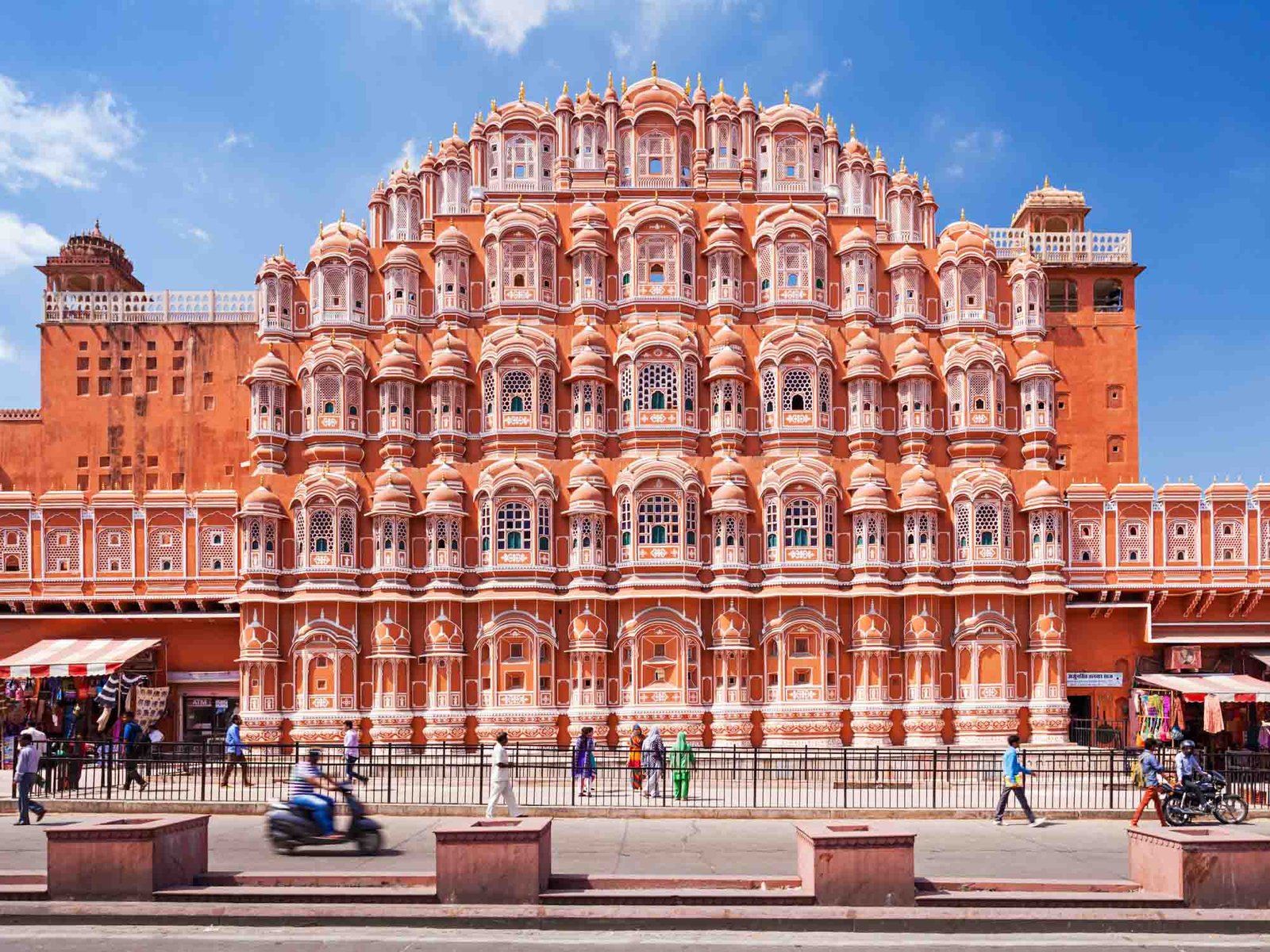
Historic Palaces and Forts
Begin your journey at the City Palace, a sprawling complex that seamlessly blends Rajasthani and Mughal architecture. Wander through its ornate courtyards, gardens, and museums, where artifacts of the royal family are on display. Just a stone’s throw away, the iconic Hawa Mahal, or Palace of Winds, beckons with its unique facade of 953 small windows, designed to allow royal ladies to observe street festivals without being seen.

Vibrant Markets and Culinary Delights
Jaipur’s markets are a treasure trove of traditional crafts and souvenirs. Johari Bazaar is famous for its exquisite jewelry, while Bapu Bazaar offers vibrant textiles and handicrafts. Strolling through these bustling markets, you can feel the pulse of Jaipur’s lively culture.
Savor the flavors of Rajasthan with a visit to local eateries. Relish the traditional Rajasthani thali, a platter brimming with a variety of local dishes. Indulge your sweet tooth with ghewar, a honeycomb-like dessert, or pyaaz kachori, a spicy onion pastry that is a local favorite.
Cultural Extravaganza
As evening falls, Jaipur comes alive with cultural performances. Attend a folk dance show or a puppet theater to immerse yourself in the local traditions. Festivals such as Diwali, Holi, and the Jaipur Literature Festival add an extra layer of excitement to the city’s vibrant atmosphere.
Jaipur is not just a destination; it’s a living, breathing museum of history and culture that leaves every traveler with unforgettable memories.
Nestled in the southeastern region of Rajasthan, Sawai Madhopur is a gateway to one of India’s most renowned wildlife sanctuaries, the Ranthambore National Park. This charming town, steeped in history and natural beauty, offers an exhilarating escape for nature lovers and adventure seekers alike.
Historical Heritage and Natural Wonders
Sawai Madhopur itself is rich in history, having been established in the 18th century by Maharaja Sawai Madho Singh I of Jaipur. The town’s heritage is palpable, with remnants of old palaces and temples dotting the landscape. The Ranthambore Fort, a UNESCO World Heritage site, stands majestically within the national park, offering panoramic views of the lush surroundings. The fort’s ancient temples, cenotaphs, and pavilions provide a glimpse into the region’s storied past.

Ranthambore National Park: A Wildlife Paradise
The true allure of Sawai Madhopur lies in its proximity to Ranthambore National Park, a sanctuary renowned for its thriving population of Bengal tigers. Spread over 392 square kilometers, the park’s diverse terrain of dense forests, open grasslands, and serene lakes creates an ideal habitat for a variety of wildlife.
Embarking on a safari through Ranthambore is an unforgettable experience. As you traverse the rugged paths, the possibility of encountering a majestic tiger in its natural habitat is thrilling. Besides tigers, the park is home to leopards, sloth bears, sambar deer, and a plethora of bird species, making it a haven for wildlife enthusiasts and photographers.
Cultural and Culinary Delights
After an adventurous day in the wild, explore the local markets of Sawai Madhopur, where vibrant Rajasthani crafts and textiles await. Indulge in the local cuisine, savoring traditional dishes like dal baati churma and spicy laal maas.
Sawai Madhopur and Ranthambore offer a harmonious blend of history, culture, and nature. This unique destination promises an enriching and exhilarating escape, leaving visitors with memories of untamed wilderness and regal heritage
For tourists yearning to explore the depths of Rajasthan’s storied past, Chittorgarh offers an unparalleled journey through time. This historic city, known for its majestic fort and tales of valiant heroes and heroines, stands as a testament to the indomitable spirit of Rajputana.
 The Magnificent Chittorgarh Fort
The Magnificent Chittorgarh Fort
The highlight of Chittorgarh is undoubtedly the Chittorgarh Fort, a UNESCO World Heritage site. Perched atop a 180-meter-high hill and sprawling over 700 acres, the fort is one of the largest in India. As you walk through its ancient gates, you are transported back to an era of grandeur and heroism. The fort’s seven massive gates, each with its own story, lead to a treasure trove of historical structures.
Historical and Architectural Marvels
Within the fort’s expansive walls lie numerous palaces, temples, and monuments. The Rana Kumbha Palace, with its towering architecture and historical significance, invites exploration. Nearby, the Rani Padmini Palace, surrounded by a serene lotus pool, echoes the tragic tale of Queen Padmini’s self-sacrifice. The fort’s temples, such as the Meera Temple and the Kalika Mata Temple, reflect the spiritual fervor and architectural finesse of the era.
 Tales of Valor and Sacrifice
Tales of Valor and Sacrifice
Chittorgarh is synonymous with the legendary tales of bravery and sacrifice. The fort has witnessed three major sieges and the heroic acts of its defenders. The story of Rani Padmini’s jauhar (self-immolation) to protect her honor against invaders is etched into the very soul of this city, inspiring visitors with its poignant reminder of Rajput valor.
Cultural and Local Flavors
Beyond its historical allure, Chittorgarh offers a glimpse into Rajasthan’s vibrant culture. The local markets are brimming with traditional crafts, textiles, and souvenirs. Savoring the local cuisine, such as dal baati churma and gatte ki sabzi, provides a delightful taste of regional flavors.
Practical Information
For tourists, the best time to visit Chittorgarh is from October to March, when the weather is pleasant. The city is well-connected by road and rail, making it easily accessible.
Chittorgarh is not just a destination; it is an evocative journey through history, heroism, and heritage that leaves an indelible mark on every visitor.
Udaipur, often heralded as the “Venice of the East,” is a mesmerizing city in Rajasthan renowned for its stunning lakes, palaces, and rich cultural heritage. For tourists, Udaipur offers a captivating blend of natural beauty and regal splendor that makes it an unforgettable destination.
A Symphony of Lakes
The city’s moniker, “City of Lakes,” is well-deserved, with its scenic water bodies creating a serene and picturesque landscape. Lake Pichola, the most famous of Udaipur’s lakes, is an artificial freshwater lake that dates back to the 14th century. A boat ride on Lake Pichola offers enchanting views of the City Palace, Jag Mandir, and the iconic Lake Palace, which appears to float gracefully on the water’s surface. Fateh Sagar Lake, another jewel in Udaipur’s crown, is surrounded by hills and boasts a serene ambiance perfect for a leisurely stroll or a tranquil boat ride.
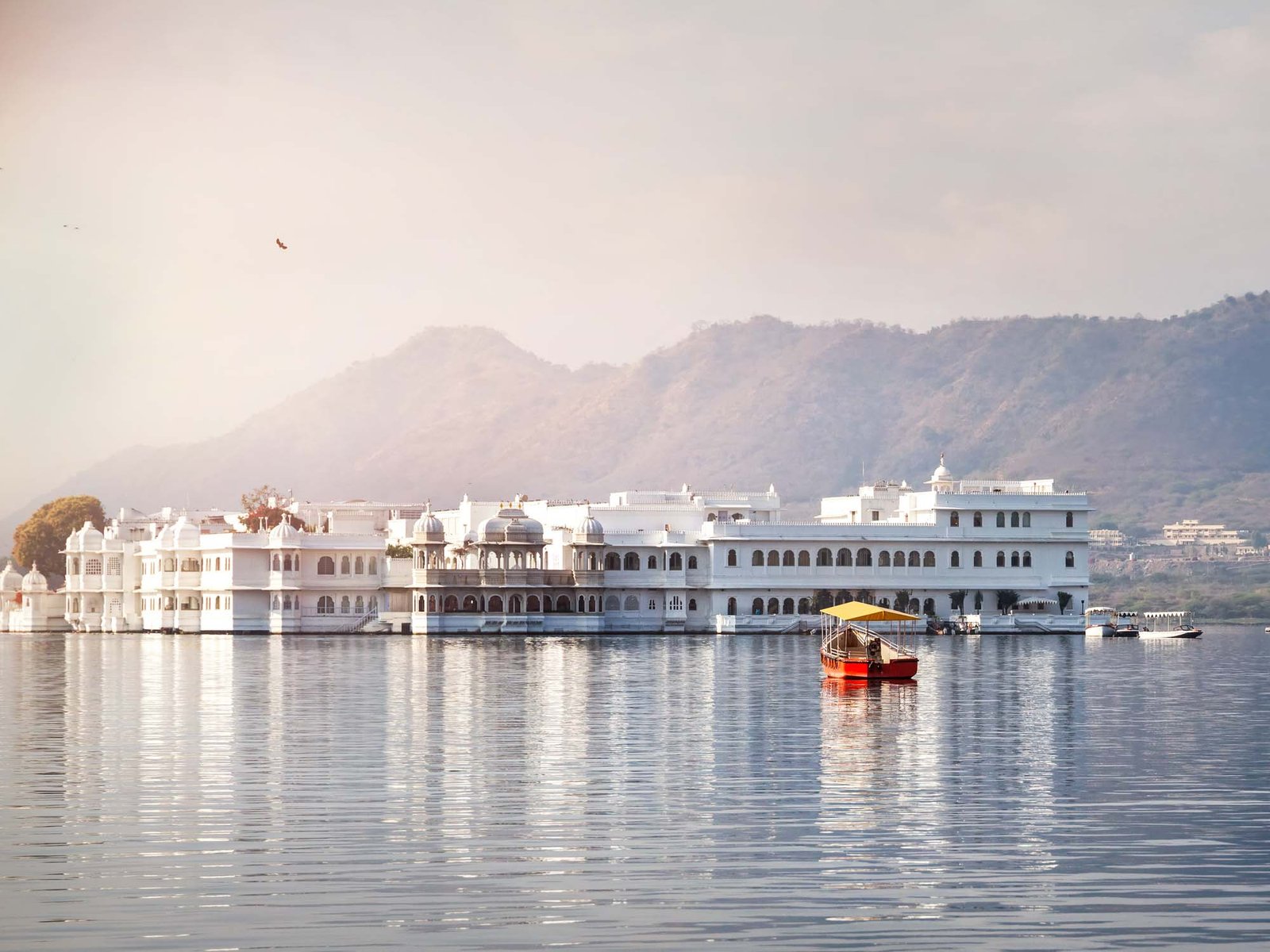
Majestic Palaces and Architectural Marvels
Udaipur’s architectural heritage is epitomized by the grand City Palace complex. Overlooking Lake Pichola, the City Palace is a vast edifice of balconies, towers, and courtyards, reflecting a fusion of Rajasthani and Mughal architecture. Within its walls, the palace houses museums, galleries, and royal artifacts that narrate the history of Udaipur’s maharajas.
The Lake Palace, now a luxurious hotel, is an exquisite example of Rajput architecture. Built entirely in white marble, it offers an ethereal experience for visitors, whether staying at the hotel or admiring its beauty from a boat on Lake Pichola.

Cultural Richness and Vibrant Markets
Beyond its lakes and palaces, Udaipur is a hub of vibrant culture. The bustling markets, such as Hathi Pol and Bada Bazaar, are treasure troves of traditional Rajasthani crafts, textiles, and jewelry. The city’s culinary scene, featuring local delicacies like dal baati churma and the sweet delight ghewar, is a treat for the taste buds.
Practical Tips
The best time to visit Udaipur is during the cooler months from October to March. The city is well-connected by air, rail, and road, making it easily accessible for tourists.
Udaipur’s harmonious blend of natural beauty, architectural grandeur, and cultural richness makes it a must-visit destination, leaving every visitor spellbound by its charm.
For travelers seeking a unique blend of history, culture, and desert adventure, Jaisalmer stands out as a dazzling gem in Rajasthan’s crown. Known as the “Golden City,” Jaisalmer is famed for its yellow sandstone architecture that glows golden at sunset, captivating every visitor.
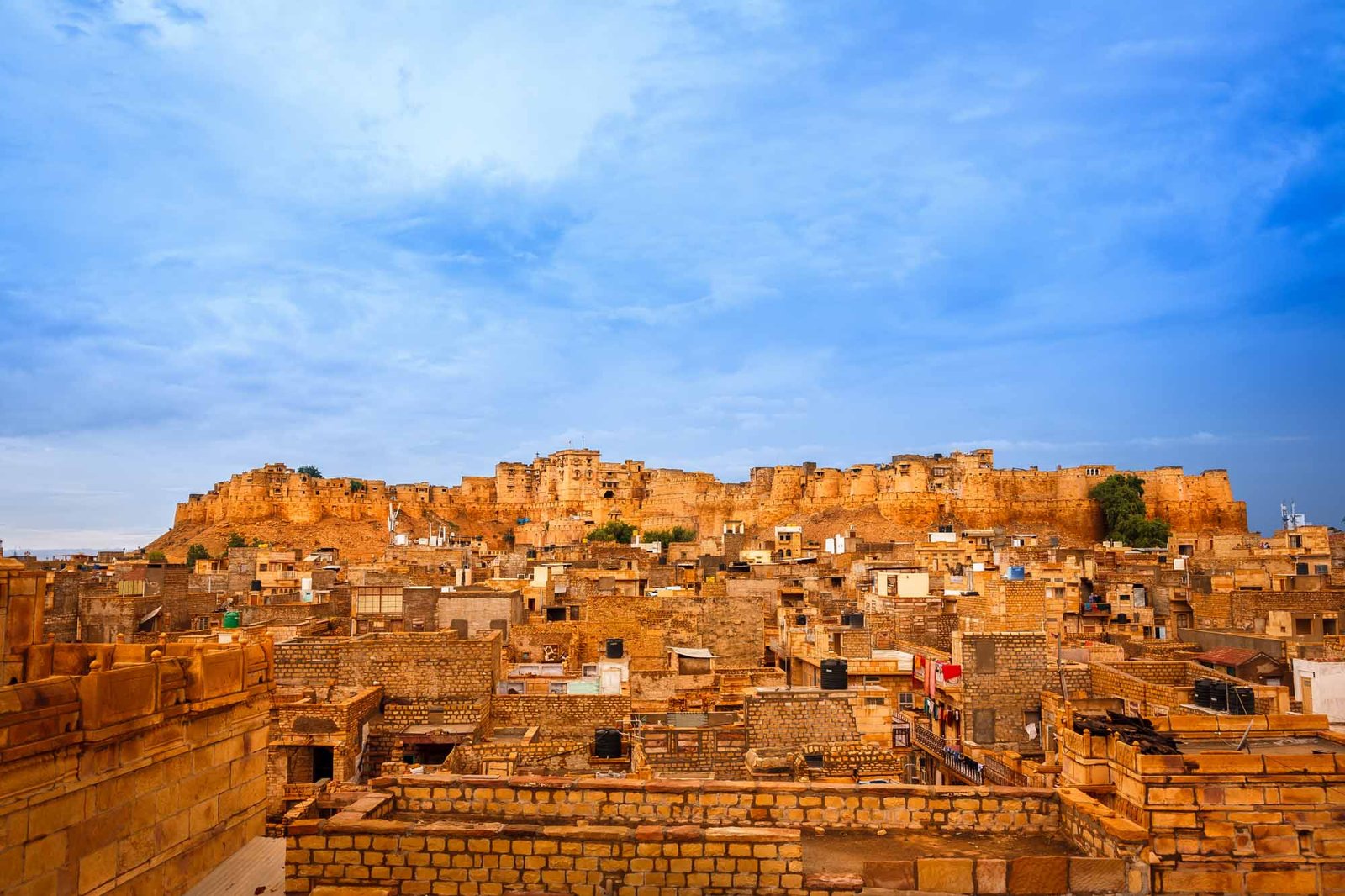 Jaisalmer Fort: A Living Citadel
Jaisalmer Fort: A Living Citadel
The heart of Jaisalmer is its magnificent fort, a UNESCO World Heritage site and one of the few living forts in the world. Built in 1156 AD by Rawal Jaisal, this sprawling sandstone fortress houses shops, hotels, and ancient homes, making it a vibrant hub of activity. Within its walls, you can explore the intricate Jain temples adorned with detailed carvings and the opulent Maharaja’s Palace, which offers panoramic views of the city and the surrounding desert.
Havelis: Architectural Masterpieces
Jaisalmer’s havelis, or traditional mansions, are architectural marvels that showcase the craftsmanship of yesteryears. The Patwon Ki Haveli, a cluster of five havelis, is particularly noteworthy for its elaborate facades and ornate balconies. Similarly, Nathmal Ki Haveli and Salim Singh Ki Haveli, with their unique designs and intricate stonework, offer a glimpse into the affluent lifestyle of Jaisalmer’s former merchants.
 Thar Desert Adventures
Thar Desert Adventures
The vast expanse of the Thar Desert offers thrilling adventures just a short distance from the city. Camel safaris are a quintessential Jaisalmer experience, taking you through rolling sand dunes and offering the chance to witness spectacular desert sunsets. For a more luxurious desert experience, stay at one of the many desert camps that offer cultural performances, traditional Rajasthani cuisine, and stargazing under the clear desert sky.
Cultural Riches and Local Cuisine
Jaisalmer is a cultural hotspot, with local artisans selling beautifully crafted textiles, jewelry, and souvenirs. The Desert Festival, held annually, showcases folk music, dance, and camel races, providing an immersive cultural experience. Don’t miss the local cuisine, with dishes like ker sangri, a unique desert bean preparation, and ghotua laddoo, a traditional sweet treat.
Practical Tips
The best time to visit Jaisalmer is from October to March, when the weather is cooler and more pleasant. The city is well-connected by road, rail, and air, making it accessible for tourists.
Jaisalmer, with its golden allure and rich heritage, promises an unforgettable journey into the heart of the desert and the soul of Rajasthan.
For tourists eager to explore the vibrant essence of Rajasthan, Jodhpur, known as the “Blue City,” offers a captivating blend of history, culture, and architectural splendor. The city’s azure-hued buildings, set against the backdrop of the majestic Thar Desert, create a picturesque and unforgettable experience.
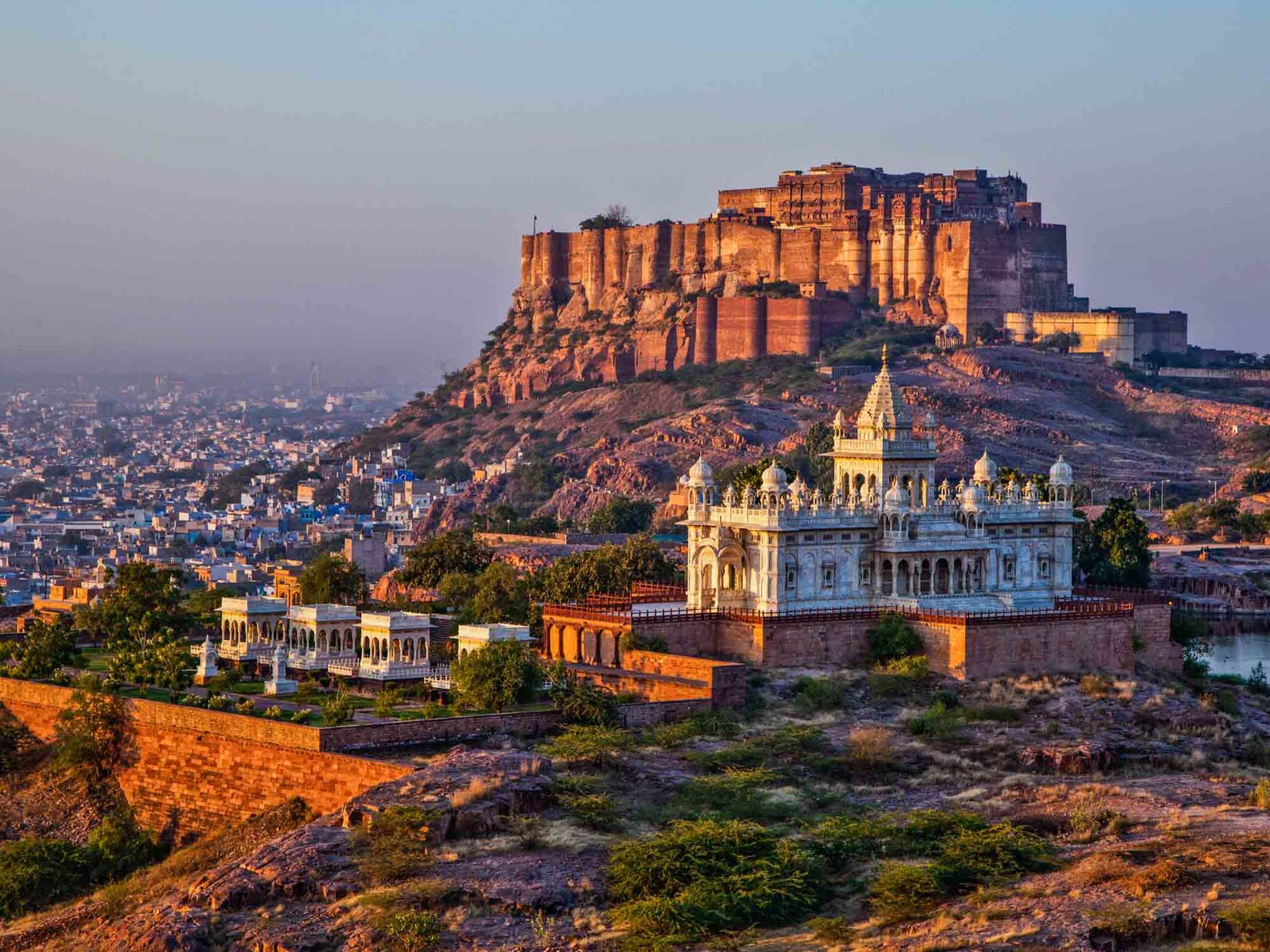 Mehrangarh Fort: A Majestic Sentinel
Mehrangarh Fort: A Majestic Sentinel
Dominating the skyline of Jodhpur is the imposing Mehrangarh Fort, one of the largest and most magnificent forts in India. Perched on a rocky hill, the fort offers breathtaking views of the city below. Inside, visitors can explore grand palaces, intricate carvings, and expansive courtyards. The museum within the fort showcases a splendid collection of artifacts, including palanquins, weapons, and royal attire, offering a deep dive into the region’s regal past.
The Blue City: A Colorful Canvas
Jodhpur’s old city is a maze of narrow, winding streets lined with blue-painted houses. This vibrant blue hue, originally a sign of the Brahmin caste, now adds to the city’s charm. Walking through these streets, visitors encounter bustling markets, local artisans, and friendly residents. The Clock Tower and the nearby Sardar Market are bustling centers of activity where one can shop for spices, handicrafts, textiles, and traditional Rajasthani jewelry.
 Umaid Bhawan Palace: A Royal Residence
Umaid Bhawan Palace: A Royal Residence
A visit to Jodhpur is incomplete without exploring the Umaid Bhawan Palace, a magnificent example of Indo-Saracenic architecture. Part of the palace is still the residence of the royal family, while the rest has been converted into a luxurious hotel and a museum. The museum offers insights into the history of the royal family and the construction of the palace, which was built to provide employment to the people during a famine in the 1920s.
Culinary Delights and Cultural Experiences
Jodhpur is a haven for food lovers, offering delectable Rajasthani cuisine. Savor local delicacies like dal baati churma, mirchi vada, and the famous mawa kachori. For a truly immersive experience, attend a traditional folk music and dance performance, which brings the rich cultural heritage of Rajasthan to life.
Practical Tips
The best time to visit Jodhpur is from October to March, when the weather is pleasant. The city is well-connected by air, rail, and road, making it accessible from major Indian cities.
Jodhpur, with its blend of historical grandeur and vibrant local culture, promises an enchanting journey through the heart of Rajasthan, leaving every traveler with cherished memories.
For nature enthusiasts and birdwatchers, Bharatpur National Park, also known as Keoladeo Ghana National Park, is a must-visit destination in Rajasthan. This UNESCO World Heritage site, located in the city of Bharatpur, offers a serene escape into a world teeming with avian diversity and natural beauty.
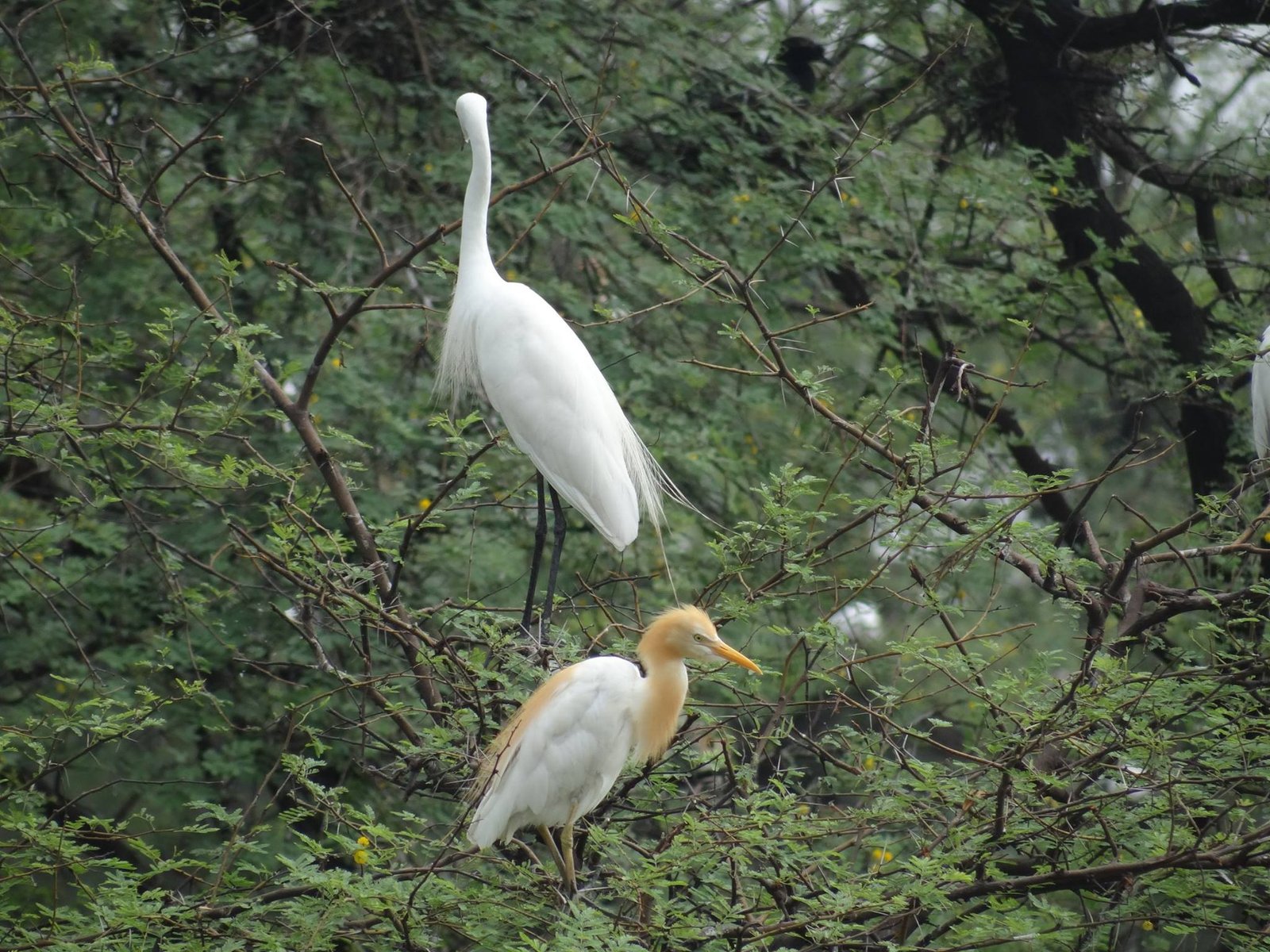 Avian Wonderland
Avian Wonderland
Bharatpur National Park is renowned for its incredible diversity of bird species. Spanning over 29 square kilometers, this park is home to more than 370 species of birds, making it one of the most important bird sanctuaries in the world. During the winter months, from October to March, the park transforms into a haven for migratory birds from as far as Siberia and Central Asia. Visitors can witness the majestic Siberian crane, painted stork, and the vibrant kingfisher among many others. The park’s wetlands, woodlands, and grasslands provide ideal habitats for these birds, creating a mesmerizing spectacle of colors and sounds.
Exploring the Park
One of the best ways to explore Bharatpur National Park is by renting a bicycle or hiring a rickshaw with a knowledgeable guide. These eco-friendly options allow for a leisurely pace, perfect for observing the diverse birdlife and other wildlife, including spotted deer, wild boar, and various reptiles. The park’s well-maintained trails and observation points provide excellent vantage spots for birdwatching and photography.
Historical Significance
Beyond its natural allure, Bharatpur National Park holds historical significance. The park was originally a royal hunting reserve for the Maharajas of Bharatpur and was later transformed into a bird sanctuary. The Keoladeo Temple, situated within the park, adds a touch of cultural heritage to the natural landscape. The temple, dedicated to Lord Shiva, gives the park its name, “Keoladeo.”
Practical Tips
The best time to visit Bharatpur National Park is during the winter months when migratory birds are in full presence. Early mornings and late afternoons are ideal for birdwatching. The park is easily accessible by road and rail, with Bharatpur being well-connected to major cities like Delhi and Jaipur.
Bharatpur National Park offers a unique blend of natural beauty and biodiversity, making it a paradise for birdwatchers and nature lovers alike. A visit to this park promises a tranquil retreat into the heart of nature, with unforgettable encounters with its avian residents.
For tourists around the world, Agra stands as an epitome of love, history, and architectural grandeur. Nestled on the banks of the Yamuna River in Uttar Pradesh, this city is synonymous with the iconic Taj Mahal, a symbol of eternal love and one of the New Seven Wonders of the World.
 The Taj Mahal: A Monument of Love
The Taj Mahal: A Monument of Love
The Taj Mahal, an ivory-white marble mausoleum, was commissioned by Emperor Shah Jahan in memory of his beloved wife, Mumtaz Mahal. Completed in 1653, this UNESCO World Heritage site is renowned for its breathtaking beauty and symmetrical perfection. Visitors are captivated by its shimmering reflection in the long pool that leads to the main entrance, the intricate marble inlay work, and the lush gardens that surround it. Visiting the Taj Mahal at sunrise or sunset offers a mesmerizing experience as the marble changes hues with the light.
 Agra Fort: A Historical Marvel
Agra Fort: A Historical Marvel
Just a short distance from the Taj Mahal, the Agra Fort is another UNESCO World Heritage site that offers a deep dive into India’s Mughal history. This red sandstone fortress, built by Emperor Akbar in 1565, encompasses a labyrinth of palaces, mosques, and halls. Highlights include the Jahangir Mahal, the Diwan-i-Khas, and the Diwan-i-Am, each showcasing exquisite Mughal architecture and offering panoramic views of the Taj Mahal from afar.
Fatehpur Sikri: The Ghost City
A short drive from Agra takes you to Fatehpur Sikri, the erstwhile capital of the Mughal Empire. This well-preserved ghost city, built by Emperor Akbar, features stunning architecture with the Buland Darwaza, Jama Masjid, and the tomb of Salim Chishti. The city’s deserted streets and grand edifices tell tales of its short-lived grandeur.
Cultural and Culinary Delights
Agra’s bustling markets, like Sadar Bazaar and Kinari Bazaar, are perfect for shopping traditional crafts, leather goods, and marble inlay items. The city’s culinary scene is equally enchanting, with local delicacies like petha (a sweet made from ash gourd), Mughlai dishes, and chaats offering a delightful gastronomic journey.
Practical Tips
The best time to visit Agra is from October to March, when the weather is pleasant. Agra is well-connected by road, rail, and air, making it easily accessible from major Indian cities. Hiring a local guide can enrich your experience with historical anecdotes and cultural insights.
Agra, with its blend of historical wonders and vibrant culture, promises an unforgettable experience. The city’s timeless beauty, epitomized by the Taj Mahal, leaves every visitor with cherished memories of their journey through India’s rich heritage.

USA & Canada: 416-619-7795
UK: +44 1753 201201 • Cell/WhatsApp: + 44 ( 0 ) 7739716978




WhatsApp us